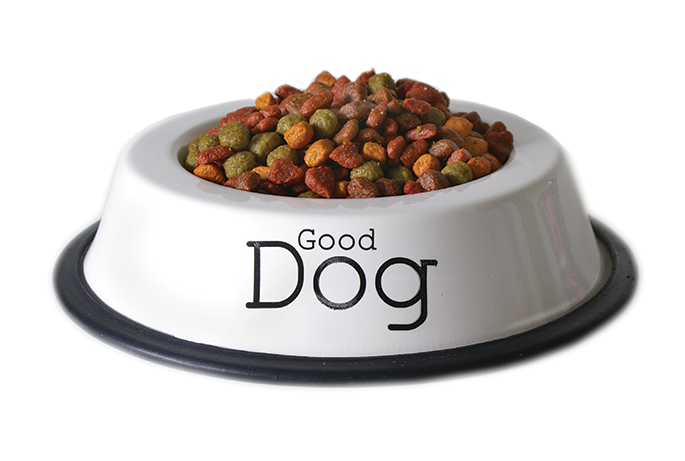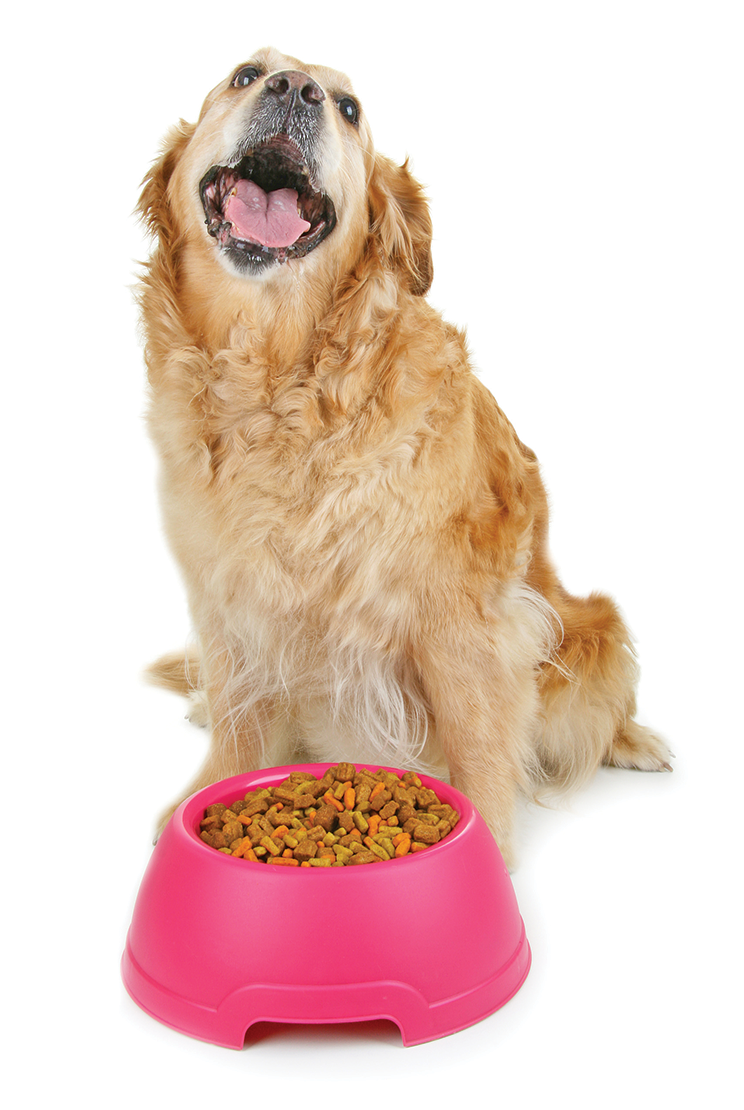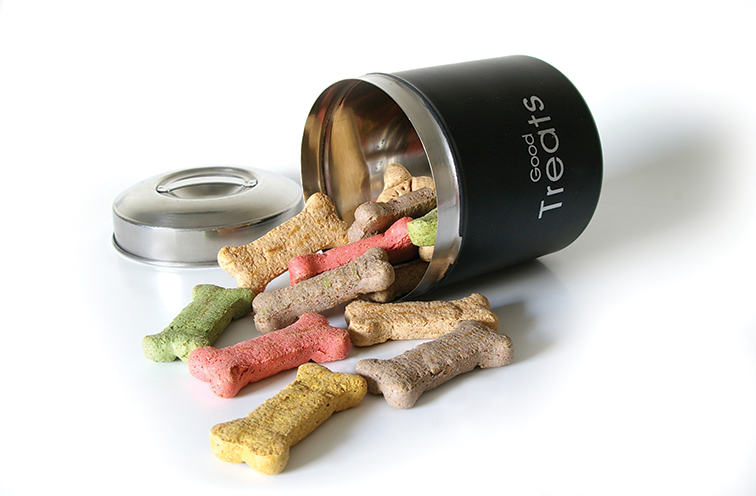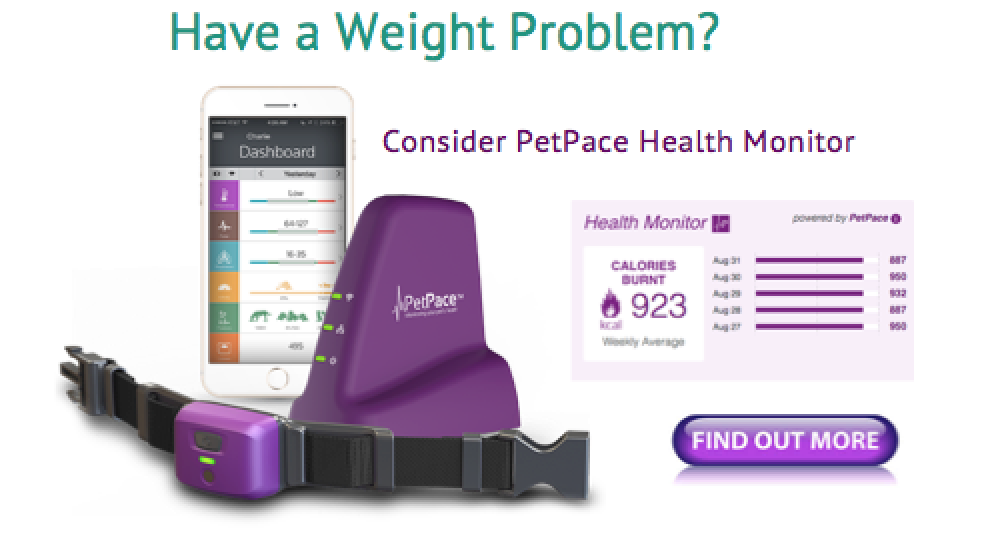Based on “Sammy” weight we would recommend feeding a large breed adult food formulation. You may adjust this further to suit the lifestyle, age and level of activity “Sammy” will be engaged in (see below).
|
General Nutritional Advice for Puppies and Dogs.
|
|
 Good nutrition is essential for your dog to have a healthy, happy life, and what your dog eats will affect every aspect of his life. It is critical that he has the correct amounts of energy, protein, fatty acids, carbohydrates and trace minerals and nutrients for growth as well as maintenance of a healthy body and brain. Nutrition is vital to a dog?s ability to think clearly, as thinking requires mental energy and the correct amino acid balance for the maintenance of normal brain chemistry. Poor nutrition, e.g. poor quality protein in the diet, or a diet that is not balanced can lead to behaviour problems, as the dog cannot focus properly and will "act out" because he does not understand what you are trying to teach him. It can lead to increased stress levels and reduced immune system function, making the dog more vulnerable to toxins and the various infectious agents that he is exposed to in everyday life. Overall this leads to a reduced lifespan and a reduction in his quality of life, due to an increase in illness and general lack of wellbeing. So, how do you know if your dog?s diet is good or bad? There are several options when feeding your dog - generally the easiest in terms of ensuring a good quality and well balanced diet is to buy a high quality commercial dog food. We shall discuss what makes a dog food "good quality" shortly. More and more people, including some vets, are now advocating raw food diets, or "natural" diets for dogs. Good nutrition is essential for your dog to have a healthy, happy life, and what your dog eats will affect every aspect of his life. It is critical that he has the correct amounts of energy, protein, fatty acids, carbohydrates and trace minerals and nutrients for growth as well as maintenance of a healthy body and brain. Nutrition is vital to a dog?s ability to think clearly, as thinking requires mental energy and the correct amino acid balance for the maintenance of normal brain chemistry. Poor nutrition, e.g. poor quality protein in the diet, or a diet that is not balanced can lead to behaviour problems, as the dog cannot focus properly and will "act out" because he does not understand what you are trying to teach him. It can lead to increased stress levels and reduced immune system function, making the dog more vulnerable to toxins and the various infectious agents that he is exposed to in everyday life. Overall this leads to a reduced lifespan and a reduction in his quality of life, due to an increase in illness and general lack of wellbeing. So, how do you know if your dog?s diet is good or bad? There are several options when feeding your dog - generally the easiest in terms of ensuring a good quality and well balanced diet is to buy a high quality commercial dog food. We shall discuss what makes a dog food "good quality" shortly. More and more people, including some vets, are now advocating raw food diets, or "natural" diets for dogs. There are some drawbacks to this approach. Firstly, raw meats can transmit parasites (such as toxoplasmosis) and bacteria that can make your dog very ill, such as Salmonella, E.coli and Enterobacter. Raw meat can spoil very quickly, especially in warmer weather, and can generally not be stored for later feeding. Commercial raw meats ("pet meat" or "pet mince") generally have preservatives added, some of which can be dangerous. Be aware that in many countries the pet meat industry is less regulated than the human meat industry, and a lot of preservatives may be added to meat, some of which can make the meat look red when in fact it is starting to spoil. Most veterinary nutritionists recommend that all meat fed to animals should be well cooked, the same as if it were being fed to people. Secondly, it can be very difficult when home preparing meals to ensure that the meal is well balanced with all the nutrients your dog requires, in a form that will be easily digestible and absorbed by your dog?s digestive system and that will be palatable to your dog. Vitamins and minerals must be present not only in the correct amounts, but in the correct ratio in respect to one another, otherwise deficiencies can occur. Remember that commercial pet foods are quality tested to ensure that they are fully balanced to meet your dog?s requirements, and many are available that are of excellent quality. With a little effort you can generally find a dog food of very high quality if you know what to look for, and know what to avoid. Always look for a diet that is accredited by the regulator in your country.  So how do you go about finding a fully balanced, good quality commercial dog food? The first thing to remember is that ingredients on the label must be listed in order of how much the diet contains. This means the first listed ingredient in a food in theory is the ingredient that the food has the most of, the second ingredient is the one that the food has the second most of, and so on. Note that if the first ingredient is a meat - e.g. chicken - a lot of this meat is actually water. Once the food is cooked and processed, a lot of this water is removed, leaving maybe 20% of the original weight of the ingredient. So if the second ingredient is a grain - e.g. corn - there may actually be more corn than chicken in the food! If however, the first ingredient is chicken meal, this means that the water has already been removed from the chicken meat (before adding it to the formula and weighing it for the ingredient list), and so the product is more likely to have a high content of animal protein. Ideally there should be more animal-based protein in a food than grain protein. Animal proteins are more digestible than protein from grain sources - this means the dog can utilise more of the food, and less is wasted and passes through the gut unused. So how do you go about finding a fully balanced, good quality commercial dog food? The first thing to remember is that ingredients on the label must be listed in order of how much the diet contains. This means the first listed ingredient in a food in theory is the ingredient that the food has the most of, the second ingredient is the one that the food has the second most of, and so on. Note that if the first ingredient is a meat - e.g. chicken - a lot of this meat is actually water. Once the food is cooked and processed, a lot of this water is removed, leaving maybe 20% of the original weight of the ingredient. So if the second ingredient is a grain - e.g. corn - there may actually be more corn than chicken in the food! If however, the first ingredient is chicken meal, this means that the water has already been removed from the chicken meat (before adding it to the formula and weighing it for the ingredient list), and so the product is more likely to have a high content of animal protein. Ideally there should be more animal-based protein in a food than grain protein. Animal proteins are more digestible than protein from grain sources - this means the dog can utilise more of the food, and less is wasted and passes through the gut unused. Animal-based protein, including specified meats, dairy products and egg, is referred to as high quality protein, and is important for a healthy immune system, good mental functioning and a good coat quality. Avoid a diet that contains unspecified meat - ingredients listed as ""poultry" or "animal protein". Often this will be the waste products of meat production that is considered unfit for human consumption. It will often contain a lot less actual meat protein. Look for specified meat, such as "chicken", "chicken meal", "lamb", "pork" etc. Avoid anything termed a "by-product" e.g. "meat by-product" "poultry by-product" etc. This may mean feet, beaks, feathers, fur etc and often contains very little meat! Also note that animal fat or animal tallow is not a source of protein, and is often added to a diet high in grain protein in order in increase palatability (i.e. make it taste better). If the first few ingredients are all grains and include an animal fat e.g. "chicken tallow" this indicates a lower quality diet that is not as preferable as one with a high content of animal proteins.  So, to sum up - an ideal commercial dog food should contain: *More animal-based protein than grain-protein.*A specified meat or meat meal as the first ingredient.*3 of the first 5 ingredients ideally should be specified animal-based (including dairy products or eggs) ingredients.*A fully balanced formulation with added antioxidants.*An explanation of the ingredients in it and why they are added. Avoid diets with soy protein, as these can be associated with allergies in dogs, and may lead to skin problems, chronic diarrhoea and other chronic problems. Similarly, corn has reportedly been linked to an increase in allergies in some dogs, with a possible association with skin and joint problems. Note that terms such as "all natural" and "premium" on a label do not have any legal standing and as such are not reliable indicators of content of the food. However, if a formulation carries accreditation (e.g. Accredited to AS 5812) this means that the product has been independently tested and meets the requirements for accreditation (e.g. for Australian Standard 5812 - a set standard for the manufacture and marketing of pet food). Looking for this standard is a good start in ensuring safety and quality in the manufacturing process. So, to sum up - an ideal commercial dog food should contain: *More animal-based protein than grain-protein.*A specified meat or meat meal as the first ingredient.*3 of the first 5 ingredients ideally should be specified animal-based (including dairy products or eggs) ingredients.*A fully balanced formulation with added antioxidants.*An explanation of the ingredients in it and why they are added. Avoid diets with soy protein, as these can be associated with allergies in dogs, and may lead to skin problems, chronic diarrhoea and other chronic problems. Similarly, corn has reportedly been linked to an increase in allergies in some dogs, with a possible association with skin and joint problems. Note that terms such as "all natural" and "premium" on a label do not have any legal standing and as such are not reliable indicators of content of the food. However, if a formulation carries accreditation (e.g. Accredited to AS 5812) this means that the product has been independently tested and meets the requirements for accreditation (e.g. for Australian Standard 5812 - a set standard for the manufacture and marketing of pet food). Looking for this standard is a good start in ensuring safety and quality in the manufacturing process.
|
|
|
How Much to Feed?
|
|
|
How much should you feed your dog? Well this will depend on a number of things, including your dog?s age, energy requirements (i.e. stress level and level of activity), bone structure and the quality of food that he is receiving. There is no set amount that is right for each dog, and energy needs can vary between different dog breeds, and even more between individual dogs of the same breed. Studies have shown that the energy requirements of different dogs of the same breed can vary by up to 35-40%.So the technical answer is, feed a premium quality food in just the right amount to meet the energy needs of your dog. (Note that a high quality commercial food will balance other nutrients around energy requirements). There will be a feeding guide on the pack, but remember that this is only a guide. You will need to monitor your dog?s body condition and adjust his amount of feed as you go. You should always be able to feel easily, but not see his last few ribs. As a puppy you will be weighing him regularly, and at each visit to the vet, and calculating his energy needs - your vet will show you how to assess his body condition and food requirements during this period. In order to avoid problems with obesity and overeating, you should measure your dog?s food and meal feed in at least 2 meals a day (more when he is a puppy). Most dogs will overeat if free fed (ad-lib feeding).
Vhttp://www.canadasguidetodogs.com/health/nutrition_obesity.htm Commercial Dog Food Formulations. There are a variety of diet formulations available to suit your dog?s age and lifestyle. Most people are aware that puppies should be fed a specific diet that is formulated just for puppies. But it can also be important to feed a specific diet for adult dogs that have different lifestyles. For example, an average inactive adult pet dog has a protein requirement of around 18% (high quality protein) in the diet. However, dogs that are under increased stress, such as breeding or showing dogs require a higher level of protein in their diet, and a very hard working dog requires even higher protein levels. Sled racing dogs require around 32% protein in their diet, as well as a high energy concentration, and will obviously need a different food formulation to the typical Couch Potato! Senior dogs can have different dietary requirements again, depending on their activity level and other factors. So let?s have a brief look at the different types of food that you may need for your dog |
|
|
Puppy Food
|
|
|
There are two main differences between puppies and adults when it comes to nutrition:1. Puppies have greater requirements in comparison to their weight2. Puppies have a more limited capacity for digestion compared to adults. Puppies go through their most rapid growth phase in the first six months of life, and can require up to three times as much energy as the adult maintenance requirement (on a per kilogram basis). During growth they also require a relatively higher amount of protein, for new tissue and muscle development, as well as a higher amount of essential minerals and trace nutrients. Some people have suggested feeding puppies an adult formulation but allowing them to eat more (free feeding) to achieve the increase in energy and nutrients that they require. This is because certain breeds, especially larger and giant breeds, have a known link between too high a growth rate as a puppy and worsening of some skeletal problems either in their youth (e.g. osteochondrosis) or later in life (e.g. hip dysplasia). However, this feeding strategy is inadvisable for several reasons. Firstly, puppies have a limited digestive capacity compared to the adult dog, and this type of feeding can cause digestive "overload" - leading to nutrient deficiencies. Also, adult formulations will often contain relatively more calcium than the puppy requires. An excess of calcium in the puppy diet has been shown in studies to potentiate the development of osteochondritis dissecans (a type of osteochondrosis) and can cause deficiencies of other important nutrients, such as Zinc. Hence it is important to feed a specific puppy formulation from weaning until skeletal maturity. In small breeds, this may occur from 8-12 months, however in larger breeds maturity occurs later, and does not occur until 24 months in giant breeds.
|
|
|
Small Breed Puppy Food
|
|
|
Smaller breeds are at a particular disadvantage due to their size. They have a very limited capacity in terms of the volume of food that they are able to ingest and digest at any one time. Also, due to their small size they are not able to store very much energy for use later. Hence they require a very energy and nutrient dense diet (per kilogram body weight) and also will require smaller meals to be fed more often. A very small puppy, such as a Chihuahua, requires feeding every few hours, and can be prone to episodes of hypoglycaemia (low blood glucose) if fasted for too long, which can lead to fitting (seizures) and even coma and death if not treated. It is easy to see why they require a puppy food that is specifically designed for small breeds.
|
|
|
Medium Sized Puppy Food
|
|
|
Medium sized puppies are generally fed a medium breed or regular type puppy food, which is formulated in between the two formulas described above. This means it is not as energy dense as a small breed formula, but is somewhat more energy dense and with a different mineral profile to a large or giant breed formula, so that it meets the needs of a medium sized puppy during growth and skeletal development. Always choose the correct puppy formula for your dog, and if unsure what the right puppy food is, check with your vet. We have provided a general guide for you below, based on the estimated size of your dog.
|
|
|
Large Breed Puppy Food
|
|
|
Large and giant breeds take much longer to reach skeletal maturity, and also have relatively weaker bones compared to those of smaller breeds, as the bones are less dense and more prone to remodelling. They are also much heavier, and so put more load on their growing bones. Hence larger breeds are more susceptible to increased stress loads and to developing skeletal injuries or abnormalities. It is for these two reasons that large and giant breed puppies are fed a different puppy formula to smaller breed puppies. Large breed puppy foods balance energy and nutrient requirements to meet the slower growth curve of a large breed dog, allowing time for bones to develop and strengthen properly as the body grows to its full size. Always choose the correct puppy formula for your dog, and if unsure what the right puppy food is, check with your vet. We have provided a general guide for you below, based on the estimated size of your dog.
|
|
|
Adult Dog Foods
|
|
|
There are different adult formulations that are designed to meet the different requirements of different dogs. As previously mentioned, dogs with different lifestyles will have different nutritional needs. Makers of premium dog foods provide a range of formulas to suit the needs of all dogs. Foods are generally available in an adult maintenance formulation for small breeds, medium breeds and large breeds and you should always choose a formula that best suits the size of dog that you have.
|
|
|
Small Breed Adult Food
|
|
|
These foods are generally designed to meet the specific requirements of dogs up to 10kg in body weight. This refers to their body weight when they are fully grown as an adult, and are fed an adult diet once they have finished growing and developing, usually after around 8 and 12 months in dogs of this size.
|
|
|
Medium Size Adult Food
|
|
|
These foods are typically designed for medium sized dogs or breeds, which have an adult body weight between 11 and 25 kg. Medium sized dogs will generally reach maturity after 12 months of age, before which they should be fed a puppy formulation.
|
|
|
Large Breed Adult Food
|
|
|
These formulas are designed to meet the needs of dogs who weigh between 26 and 44 kg as an adult, and will generally be formulated for the increased stress on the joints of a dog of this size, as well as their somewhat shorter gastrointestinal tract compared to their body size. Dogs of this body size generally reach maturity between 12 and 18 months of age, and should be fed an appropriate puppy food until this age.
|
|
|
Giant Breed Adult Food
|
|
|
Formulated specifically for dogs that weigh over 45 kg as fully grown adults, these foods meet the special needs of very large breed dogs. Giant breed dogs generally reach skeletal maturity between 18 and 24months of age, and require an appropriate puppy formulation up until this age. Adult dogs may vary greatly in not only their size and the amount of food required to maintain a healthy body weight, but also in lifestyle and the diet required to keep them in optimal health for their particular lifestyle. Several different types of different adult foods are described below.
|
|
|
Light food
|
|
|
However, adult formulas also come in a "light" version, for less active dogs, or those especially prone to putting on weight easily. These food types are less energy dense, so that the less active dog can eat until he feels full, but without ingesting more energy than he needs to maintain an ideal weight. Being overweight can create a number of health problems for your dog, and has been shown to be linked to a shortened life span. Joint problems and arthritis, as well as breathing problems will be made worse by being overweight. If your dog is overweight and needs to reduce weight, you should see your veterinarian, as a number of formulas specially designed to help your dog lose weight in a healthy way are also available.
|
|
|
High performance/ Active dog food
|
|
|
Also available are "performance" formulas, designed for very active and working dogs, with added energy and protein levels. These foods are specially designed for athletic dogs, and dogs that are working - e.g. hunting dogs, farm and stock working dogs, and dogs involved in athletic activity such as agility, flyball, coursing etc. These diets allow animals to take in their increased requirements for protein and energy without having to increase the amount of food they need to eat, and contain very high quality protein, which can be digested more easily and will not overload the digestive system.
|
|
|
Food for?breeding bitches
|
|
|
Breeding bitches provide another nutritional challenge, requiring food to meet not only their own needs but also those of their gestating and then lactating pups. In most cases a premium quality puppy food will be best suited to meet a breeding bitches requirements, however it is always recommended to use small breed puppy formulations (i.e. avoid large breed puppy foods) for this purpose. It is not generally recommended to give calcium tablets or supplements unless recommended by your vet. See your vet for advice specific to your bitch?s needs if you are thinking of breeding.
|
|
|
Breed specific food
|
|
|
Some manufacturers will provide "breed specific" formulations, which are claimed to address breed specific nutritional needs. These can allow for commonly encountered nutritional needs in specific breeds. However remember that they are a general diet, and not tailored to any one individual dog, and in most cases these diets are probably quite suitable for a number of similar breeds and types.
|
|
|
Health specific food
|
|
|
You, may have noticed that there are also available a range of dog formulas that address specific health issues - foods such as "dental diet", "hypoallergenic diet", "sensitive skin diet" and so on. These diets have been formulated to aid in the treatment of one or more specific illnesses or health problems in dogs, and may not be suitable for all dogs. In general your vet will recommend one of these diets if they think it would be the best option for your dog. If you think a specific health-related diet may be of benefit to your dog, always discuss this with your vet before changing your dog?s diet.
|
|
|
Senior Dog Food
|
|
|
There are also a number of senior formulations on the market, designed for dogs aged 7-8 years of age and older. These foods generally have less energy, higher fibre and around 18% protein (this is the minimum high quality protein level required for adult canine maintenance). They are formulated this way because frequently older dogs are less active, may have a reduced metabolic rate, and can suffer from constipation. Dogs that benefit from these diets are those that are inclined to weight gain due to reduced metabolism and activity - bearing in mind that excess weight gain puts added stress on the joints and can also worsen any developing arthritis. Also as the dog ages the intestinal tract can lose tone, leading to an increased tendency for constipation - the higher fibre level of the senior diet can assist with this as well. However, keep in mind that this is not always the case and your dog will not suddenly stop being active at a certain age! You should still feed your dog to his individual needs, based on activity level and health status. You should consult with your vet to review your dog's individual health status and nutritional needs if you think he may benefit from a change in diet as he ages.
|
|
|
Snacks.
|
|
|
It is okay to feed snacks to your dog. Just follow a few basic guidelines to ensure that they are just snacks and not creating health problems or obesity! Firstly, feed healthy, doggy snacks - not people snacks! No biscuits, chips or other human treats - these foods are doggie junk food, high in fat and calories. Never feed your dog at the table, only in his bowl (or when training).This will avoid a lifetime of begging-type behaviour. Do not feed plate scraps that you would not eat yourself to your dog - e.g. left over veges are okay, but fat, gristle and chop bones are not! Feed healthy snacks such as sliced apple or banana, veges such as carrot or broccoli or frozen veges - beans, broccoli, carrots etc. Please note that corn cobs should NOT be fed to dogs, as the cobs are a common cause of intestinal obstruction, requiring surgery to correct. Do not feed chocolate, onion, garlic, macadamia nuts, grapes or raisins/sultanas to dogs - these are all toxic substances!
|
|
|
Hydration
|
|
|
Keeping your dog well hydrated is just as important as ensuring that he receives good nutrition. It is important to ensure that your dog always has access to clean fresh water. Dehydration can lead to kidney and heart damage, and can occur quickly if water is not available.
Clean your dog's water bowl every day. Bacteria grow rapidly in water bowls and can foul the water quickly, causing your dog to not drink it, or worse, make him sick if he does drink it. Use a small amount of dishwashing liquid and a cloth to clean, and rinse the bowl thoroughly. Ensure that the bowl is of the correct size, not too big or small. A bowl that is too small may become dry and lead to dehydration. A bowl that is too big may make it hard for your dog to reach the water as the water level drops, or for small dogs and puppies there may be a risk of them falling in trying to get to the water (e.g. in a bucket). For large dogs, a bowl that continually fills from a bottle or hose may be the best choice. For dogs with long ears a tall narrow bowl can help them avoid getting their ears wet when they drink, which can help reduce the risk of ear infections. For dogs that are indoors, several water bowls around the house can be a good idea. Never let your dog drink out of the toilet - it is unsanitary and can lead to nasty gastrointestinal diseases. If your dog likes to do this, make sure you keep your toilet lid down!
|
|


The Couch Potato
Generally happy to settle back down after going for a walk, and not particularly keen on a long run to the park
Common Couch Potatoes include Greyhounds, Basset Hounds and Wolfhounds.
Good Activities & Games:
Walking.
Either a number of short walks or long leisurely walks – whatever your dog prefers. Try to visit new places where there will be new smells and sights to see regularly and often. A good way for the Couch Potato to get out and about is to accompany you when you are out and about town on errands, or maybe visiting with friends at a cafe. Take a portable water bowl with you and he can socialise while you do!
Hide and Seek
with a toy such as a Kong containing treats can be fun for your dog. Start off with fairly easy "finds" and your dog will learn to go look for his treat. Working for food inside a Kong or other similarly designed toy gives your dog mental stimulation as well.
Coming soon !
Coming soon !
Coming soon !
Coming soon !
Powered by Orivet Genetic Pet Care
